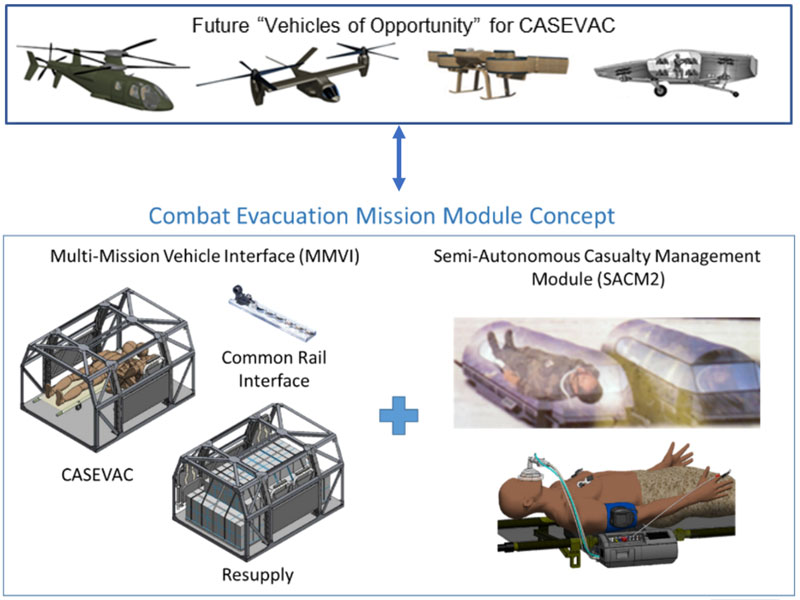MEDICAL ROBOTICS AND AUTONOMOUS SYSTEMS
MISL Lab Introduces New “Combat Evacuation Mission Module” Project
March 31, 2020 | Download PDF
TATRC’s Medical Intelligent Systems Lab (MISL) has joined forces with the U.S. Army Aeromedical Research Laboratory (USAARL) and Naval Air System Command (NAVAIR) on a new Science and Technology (S&T) effort entitled, “Combat Evacuation Mission Module” (CEMM), a Medical Robotic and Autonomous Systems (MedRAS) S&T Task Area project.
The CEMM project aims to explore methods of increasing casualty evacuation capability and capacity during Multi-Domain Operations by utilizing non-traditional evacuation platforms to expedite transport of combat casualties while still providing required en route care in high-risk or resource constrained environments. This concept includes future use-cases involving both “autonomous transport” onboard unmanned or optionally-piloted vehicles, and “autonomous treatment” through a remotely monitored and controlled treatment and patient management system. The project has both PE6.2 Applied Research aims focused on autonomous treatment en route, and PE6.3 Advanced Technology aims focused on autonomous transport.
 Figure 1: Illustration of CEMM Concept
Figure 1: Illustration of CEMM Concept The CEMM PE6.2 aims focus on providing the necessary patient- and medic-facing systems for effective remotely operated and / or semi-autonomous en route care systems. Initial research focuses on evaluating emerging en route care technologies derived from extramural and intramural research supporting the MedRAS and Virtual Health Task Areas. Additionally, approaches for providing a communication infrastructure and cyber security solutions for remote patient monitoring, and remote supervision and control of semi-autonomous patient management systems will also be investigated.
The focus of the CEMM PE6.3 effort is twofold. The first aim is to design a “Multi Mission Vehicle Interface” (MMVI) that provides a common vehicle interface for medical systems and other mission packages for future transport vehicles, including designs for physical (mounting), electrical (power), and digital (data) interfaces. This system includes a Patient Handling System (PHS) that will be designed for low space and weight applications while providing versatility and re-configurability via a standard rail mounting system, as well as innovative ways of improving patient access to care providers during transport. The second aim, called the Safe Transport and Evacuation Protocol System (STEPS), focuses on communicating with mission planning and control systems for emerging unmanned or “optionally-piloted” aircraft to ensure safe patient transport onboard future autonomous vehicles by providing patient-based flight constraints to advise evacuation missions. A Technology Transition Agreement between the CEMM S&T collaborators and PM Future Long Range Assault Aircraft (FLRAA) was signed in October 2019 for these two PE6.3 aims.
Since the start of the project in October 2019, there have been two major, significant milestones. The first milestone was the official CEMM kickoff meeting held in October 2019 at the NAVAIR Cargo and Special Operations Group office located at Patuxent River, MD. This kickoff meeting offered an opportunity for S&T collaborators from TATRC, USAARL, and NAVAIR to actively engage with stakeholders from PM FLRAA, Product Office Medical Evacuation, Medical Evacuation Concepts and Capabilities Division (MECCD) , and Joint Program Committee - 1 (JPC-1). One significant output of this meeting was to emphasize the importance of early interim deliverables required to inform the FLRAA program and aligned with the FLRAA development timeline.
The second significant project milestone was the successful completion of the requirements review for the MMVI and PHS subsystems, completed in May 2020. NAVAIR led this effort, and completed the review through engaging with collaborators and stakeholders during three separate virtual review sessions. During these long and extensive review sessions, the project team went through the system requirements document line by line and received valuable feedback from engineers and SMEs at NAVAIR, TATRC, USAARL, MECCD, and PM FLRAA. This feedback is critical to accurately defining the system requirements, which will guide the subsequent research and prototyping effort and shape the first major project deliverable to PM FLRAA slated for Q4 2020.
The completion of these initial milestones have set the CEMM project team on the right course for this multi-year collaborative research effort. “Our new project has benefited greatly from the high level of engagement that we’ve had with our stakeholders, especially MECCD and PM FLRAA, from the beginning. These stakeholders have been extremely generous in offering their subject-matter expertise and leadership to help guide us on this ambitious project. It is because of their support, and the wide-ranging competencies of our S&T collaborators, that I am optimistic that this project can have a significant impact on future casualty evacuation missions,” stated Mr. Nathan Fisher, TATRC Research Project Manager and CEMM Co-Principal Investigator.
This article was published in the September 2020 issue of the TATRC Times.